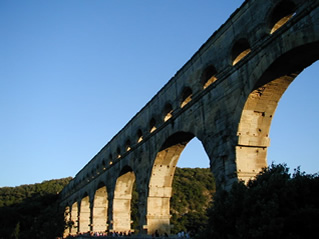Cement, Lime & History
Craftsmen have been formulating and building with cement for at least 3,000 years. The ancients used gypsum and lime cement mortars in the great pyramids in Egypt. The Chinese used it to build the Great Wall, and early Chinese mariners used a cement mixture to hold bamboo reeds together for their boats. About 800 BC, the Greeks used a limestone mortar that was harder than that used later by the Romans.
However, the ancient Romans used their mixes of sand and lime, and burning lime and pozzolan (volcanic ash from Pozzuoli, near Mt. Vesuvius) - in magnificent ways. From 300 BC to 476 AD, the Romans built the Appian Way, the Coliseum, the Pantheon, luxuriant public and private baths, and the Pont du Gard aqueduct in south France- still standing and famously painted 1,700 years after construction, by (at least) two French Masters, Hubert Robert, and Paul Cezanne. Several of Cezanne’s landscapes include less famous portions of the Roman aqueducts than the one at Pont du Gard, but are artful reminders of the extensive Roman aqueduct system, made with Roman pozzolan cement!
Between 1200 and 1500 AD, the practice of burning lime and pozzolan to make a cement admixture was mostly lost, and the quality of cement deteriorated. However, the next centuries brought new advances to the art and science of making cements. In 1796, John Smeaton invented a hydraulic mortar to rebuild a lighthouse in Cornwall, England. Within a few years, hydraulic mortars, stuccos and plaster were being patented, all for use outside, developed so water would not damage it. Portland cement was invented by Joseph Aspdin in 1824 in England. Other cement formulations continued to be used for awhile, but since the 1890’s to today, Portland cement has been the standard cement composition for masonry mortars and concrete.

